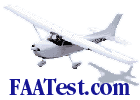After Landing Roll
The rudder serves the same purpose on the ground as it does in the air - it controls the yawing of the airplane. The effectiveness of the rudder, however, is dependent on the airflow which, of course, depends on the speed of the airplane. As the speed decreases and the nosewheel or tailwheel has been lowered to the ground, the steerable nose or tailwheel provides more positive directional control. The brakes of an airplane serve the same primary purpose as do the brakes of an automobile - that is, to reduce speed on the ground. In airplanes, however, they may also be used as an aid in directional control when more positive control is required than could be obtained with rudder, nosewheel steering, or tailwheel steering alone. To use brakes, the pilot should slide the toes or feet up from the rudder pedals to the brake pedals. If rudder pressure is being held at the time braking action is needed, that pressure should not be released as the feet or toes are being slid up to the brake pedals, because control may be lost before brakes can be applied. During the ground roll, the airplane's direction of movement may be changed by carefully applying pressure on one brake or uneven pressures on each brake in the desired direction. Caution must be exercised, however, when applying brakes to avoid overcontrolling. The ailerons, too, serve the same purpose on the ground as they do in the air - they change the lift and drag components of the wings. During the after landing roll they should be used to keep the wings level in much the same way they were used in flight. If a wing starts to rise, aileron control should be applied toward that wing to lower it. The amount required will depend on speed because as the forward speed of the airplane decreases, the ailerons will become less effective. Techniques for using ailerons in crosswind conditions ar explained further in the section on crosswind landings. After a nosewheel type airplane is on the ground, back pressure on the elevator control may be gradually relaxed to place normal weight on the nosewheel to aid in better steering. With a tail wheel type airplane, the elevator control should be held back as far as possible and as firmly as possible, until the airplane stops. This provides more positive control with tailwheel steering, tends to shorten the after landing roll, and prevents bouncing and skipping. If available runway permits, the speed of the airplane should be allowed to dissipate in a normal manner by the friction and drag of the wheels on the ground. Brakes may be used if needed to help slow the airplane. After the airplane has been slowed sufficiently and has been turned onto a taxiway or clear of the landing area, it should be brought to a complete stop. Only after this is done should the pilot retract the flaps and "clean up" the airplane. Too many accidents have occurred as a result of the pilot unintentionally operating the landing gear control and retracting the gear instead of the flap control when the airplane was still rolling. The habit of positively identifying either of these controls before actuating them, should be formed from the very beginning of flight training and continued in all future flying activities.
|

